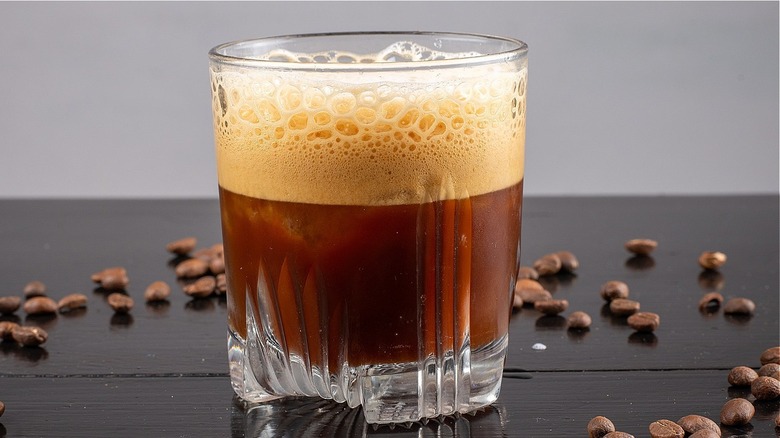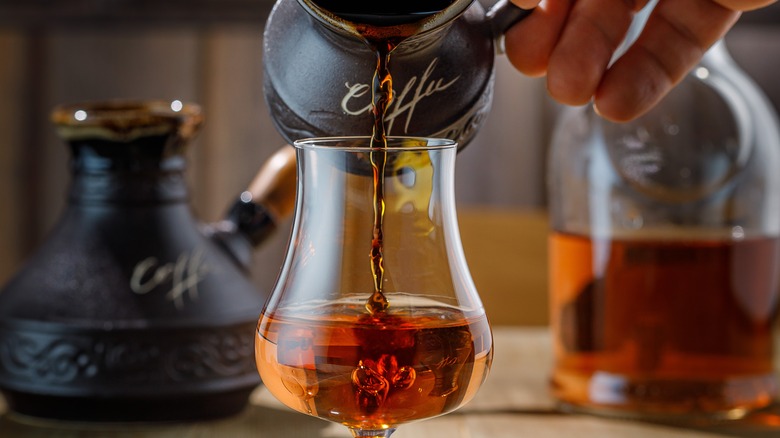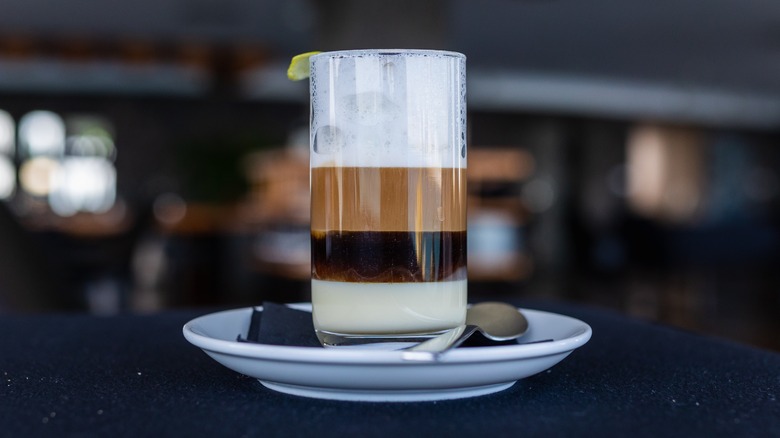The Many Forms Of Boozy Carajillo Coffee
Way back before anyone had ever dreamed of something called Red Bull – let alone made a cocktail with it – there were other, better, ways of mixing caffeine and alcohol for those looking to get a little fired up before winding down. Espresso martinis and "carajillos" are all classic drinks combining coffee and alcohol for what Juliana McIntosh's "Art of Drinking" podcast referred to as "pick me up ... then lay me down" sort of beverages.
The carajillo may have originated in Cuba. It has numerous variations, both in that purported country of origin and other parts of the Spanish-speaking world, and it would be hard to choose a favorite. Like Irish Coffee (and unlike an espresso martini), the oldest form of a carajillo uses hot coffee and is not shaken. But it's not usually for breakfast (though there seem to be notable exceptions, per Una o Dos Copas). For some, it's a delightful way of ending an evening or a good meal (via Vindulge).
There are a couple of standard ways of making the drink: you can either put some sort of high-proof alcohol in a glass and set it aflame, burning off most of the alcohol, and then add coffee, or you can start out with the coffee and add the alcohol (no fire involved), according to Una o Dos Copas.
A carajillo for courage
The flaming edition might also be referred to as a cremat or a rebentat in parts of Spain, per Una o Dos Copas. Often, sugar, citrus peel, and coffee beans are added. Other versions, like the carajillo poblano, are served cold and contain aromatics, like a cinnamon stick (via Directo al paladar). While carajillos may contain brandy, it's not the only spirit in play: Carajillos are made with a variety of liquors, including cognac and rum, not to mention regional varieties made with anise, mezcal, or a coffee liqueur (per The Yucatan Times and Nuvo).
In Catalonia, people tend to take their carajillos with rum, served in a tall glass. That rum could reflect the carajillo's possible origins; some speculate that the beverage began in Cuba while the island was still under Spanish rule: Allegedly, some genius decided to mix the famous local rum with the equally famous local coffee and serve it to local workers (or possibly, soldiers) to inject them with a little extra "coraje" (courage) for the long day ahead. This is where it purportedly gets its name (via Café Sabora and Nuvo). However, Nuvo has argued that the name likely comes from the exclamation "carajo," noting that the drink "can feel like a swift slap in the face—but in a sweet, energizing way." Another account suggests that it was first served to the working community in southern Spain to get laborers through the long, hot day.
The many layers of the carajillo
Due to the different densities of coffee and alcohol, the drink naturally displays a layered look, but some places take it a step further. In the Canary Islands the carajillo takes on another stripe by adding milk to the equation: Both regular and condensed milk are included in the tasty and photogenic beverage, which is call the "barraquito" (per Nuvo).
In Mexico, carajillos frequently include a shot of Licor 43, a secret-recipe liqueur with strong vanilla notes (per Piloncillo y vainilla and Mexican Food Journal). But while some carajillos are spiked with just one type of alcohol, other variations double the fun by including both Licor 43 and mezcal or tequila (per Ilegal Mezcal and "The Art of Drinking"). And while the most traditional carajillo is a hot coffee beverage, both hot and iced versions of the drink are now readily available, which is good news when the temperatures soar. A cold carajillo makes for a refreshing and relaxing pick-me-up on a hot summer day and provides a more cocktail-like beverage experience than its steamy counterpart.
The carajillo proves, yet again, that coffee is a great starting point for an array of great flavor options, with or without alcohol.


